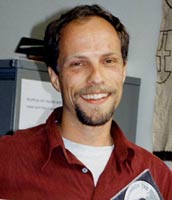The Monday before last I
blogged a bit about my visit to Schleswig from the train home. Since then, I’ve written a proper conference report that will be published in the autumn issue of
Fornvännen. That’s not until October, though, so I might as well put it on-line right away.
 Ongoing Research Into War Booty Sacrifices and Princely Graves in the Barbaricum. International Conference, Schleswig, 15–17 June 2006.
Ongoing Research Into War Booty Sacrifices and Princely Graves in the Barbaricum. International Conference, Schleswig, 15–17 June 2006.In modern-day Denmark and adjoining areas, peat bogs are sometimes found that are full of vandalised military equipment from the Late Roman Iron Age and Migration Period (2nd to 6th centuries AD). The anaerobic conditions in the bogs are such that the finds, both metal and organics, are in pristine shape. Details show that the objects were not made in the area adjoining the individual bog: instead they hint at origins sometimes in western Scandinavia, sometimes south-eastern Scandinavia, occasionally northern Germany. Boats occur too.
The scholarly consensus is that the finds represent equipment taken from unsuccessful invading armies arriving by sea. Tacitus tells of Germanic tribes that would promise any future spoils of war to their gods before a battle to improve their chances of victory. That is, they bought battle luck on credit. Apparently, the gods then wanted to have the spoils vandalised and thrown into sacred lakes. After over 1500 years, these lakes are now solid peat.
The war booty sacrifices offer a unique window on a prehistoric period whose archaeological record elsewhere is not often well preserved. Excavations and publications in the 1850s and 60s by Conrad Engelhardt brought the source category into the limelight, and it has never left it since. The best-recorded and –published war booty find is that from
Illerup Ådal in Jutland, whose co-excavator Jørgen Ilkjær has so far published ten hefty analytical volumes on the site, some together with Claus von Carnap-Bornheim.
The two collaborators are now nurturing a new generation of scholars in this field. Well-funded sister projects – one based in Århus, the other in Schleswig – have been set up, where doctoral students are re-publishing and analysing the 19th century finds in the light of the results of the Illerup studies. Funding is provided by the Carlsberg foundation and the European Social Fund. Yes,
social. From the EU’s point of view, the German project is apparently a good way to alleviate the sad social circumstances among PhD students of archaeology. Bleak indeed are their career prospects.
The projects have run since 2004/2005 and approach their half-way mark. This occasion was marked in June with a two-day conference at the Schloss Gottorf in Schleswig. The aim was to allow the projects’ participants to tell each other and other attendees what they are doing, and to offer presentations by colleagues working with other relevant material. A proceedings publication is planned. The list of attendees covers 95 names, mostly of German and Danish scholars. No Norwegians and only a single Swede were there, sad to tell: after all, it is our gear the smug Danes keep digging out of their bogs.
I went to Schleswig at the expense of the Academy of Letters to pick up news and relay it to
Fornvännen’s readers. News, however, turned out to be somewhat scarce, as the projects work mainly with well-known finds excavated very long ago and had not yet had time to move much beyond the cataloguing and dating stage.
Engelhardt published a selection of well-preserved objects from each site, giving the reader a good overview of what types were present, but no idea of the numbers or variability involved in each case. The finds from the Thorsbjerg bog became mixed up in Denmark's loss of Schleswig-Holstein to Prussia in 1864, and ended up at various German and Danish museums. Engelhardt brought one piece of each type from Thorsbjerg to Copenhagen, leaving the rest to the conquerors. Times have changed for the better: in return for the loan of the ship from the Nydam bog to the
Sejrens triumf exhibition in Copenhagen, the National Museum has now lent all its finds from Thorsbjerg to the Landesmuseum in Schleswig.
25 papers were read, many of them very literally so and in German, which tasked the audience’s powers of concentration in the balmy summer temperature. As suggested by the conference title, two main thematic blocks were offered: one on war booty finds and one on rich graves.
The doctoral students are cataloguing and preparing bog finds for complete Illerup-style publication and performing various analyses as they go along. von Carnap Bornheim’s students Ruth Blankenfeldt, Julia Gräf, Nina Lau, Suzana Matesic and Florian Westphal are all working with various aspects of Thorsbjerg. Andreas Rau studies the 1990s finds from Nydam, and his thesis will also contain a re-study of Skedemosse. Susan Möller-Wiering looks at the textiles from Illerup. In Denmark, Jørgen Ilkjær works with Vingsted, Rasmus Birch Iversen with Kragehul, Xenia Pauli Jensen with Vimose, Anne Nørgård Jørgensen with Porskjær and Per Ole Schovsbo with Tranbær. Ejsbøl currently lacks a caretaker.
The bogs received repeated offerings over the centuries: one of the projects’ aims is to test and refine current ideas about how many sacrificial episodes each site has seen, and when. Among the early finds with poor documentation, it is now increasingly possible to reconstruct sets of objects made and used together from manufacturing details and the scanty notes in Engelhardt's diaries.
Thorsbjerg is the southernmost of the great war booty bog sites, located in Schleswig-Holstein, just north of Süderbrarup. The find is unusual as it contains the equipment not of Norwegian or Swedish invaders, but of forces attacking from the south, the Altmark, near the Roman border. This shows in finds such as a much-discussed silver mask. Is it part of a Roman parade helmet? According to Thomas Fischer of Cologne this is unlikely: they weren't made of thick solid silver like the Thorsbjerg mask. Instead, he suggests that it is the re-worked face of a 3rd century cult statue, looted from a temple in Gaul. This would likely make it a later functional relative of the recently found
bronze mask from Västra Vång in Blekinge, Sweden (published in
Fornvännen 2006:3). I find this interpretation, supported by finds of closely similar silver god faces, attractive and convincing.
Thematically related to the bog finds although separated from them by centuries, a fascinating look into the grisly cultic habits of La Tène-period Gaul was given by the polyglot Jean-Louis Brunaux, excavator of the
rural temple complex at Ribemont-sur-Ancre near Amiens. Here a Roman temple was built upon the remains of what Brunaux interprets as a tropaion and monument erected on a battlefield c. 250 BC. The losing side’s dead were decapitated and their bodies and gear displayed for a long time before being buried in a great ossuary, one of the few large finds of unburnt human bones known from this time and area. A great cremation pit, meanwhile, most likely represents the fallen of the winning side. (An early illustrated report on the site is found in
Fornvännen 1984).
Arne Jouttijärvi presented very interesting interpretations of metallurgical analyses of copper alloy objects from the bogs. Such data allow him to assign objects or parts of such to individual casting episodes, and so to re-unite objects disassociated either when they were sacrificed or when they were excavated in the 19th century. In Jouttijärvi’s sample, details of the objects’ design confirm such links nicely. The links also help identify individual sacrificial episodes within large bogs such as Ejsbøl. The evaporation of zinc from open crucibles offers relative chronology: low-zinc rivets with a characteristic alloy composition on one mount can for example be identified as made from re-melted leftovers from the casting of another high-zinc mount. I would love to see such studies applied to grave finds as well, to strengthen the identification of the defeated armies’ origins. And, as Xenia Pauli Jensen suggested, it would be most interesting if it were possible to link a broken object with a well-documented find context at Illerup to a fragment excavated somewhere else by Engelhardt. This would mean that the spoils from one battle could end up in several sacred lakes.
In the concluding segment, we learned some exciting news about princely graves of the Early Roman Period Lübsow group and the Late Roman Period Hassleben-Leuna group. Papers were given on Lübsow and Gommern, and unpublished grave finds of eye-popping splendour from Neudorf-Bornstein and Hagenow in Schleswig-Holstein as well as Vorbasse in Jutland were presented. Finally, Susanne Wilbers-Rost and Achim Rost told us the latest news from the AD 9 battlefield at Kalkriese, including enlightening work on the archaeological formation processes at the site, which must have included not only a battle lasting for days but also an extended period of post-battle looting.
All in all, it was a stimulating conference and a pleasure to meet with so many colleagues keenly interested in solid, well-preserved finds. Sweden has at least two great war booty bog sites comparable to the Danish ones: Skedemosse on Öland and Finnestorp in Västergötland. The low known number is probably largely due to our abundant forests. The Danes have little woodland, so historically they have burnt a lot of bog peat, and so they have made a lot of bog finds. Finnestorp has been excavated for several seasons in the 00s by Bengt Nordqvist in collaboration with the metal detecting section of the Göteborg Archaeological Society. (I myself have had the pleasure of working with them in Östergötland.) The finds are similar in quality and date to Ejsbøl, with a great number of beautiful chip-carved strap mounts. There is no doubt in my mind that we could find more of these sites if we made goal-orientated forays into Swedish wetlands. Then we might learn what sort of pressure the Danes themselves were applying to the north and east 1800 years ago.
[More blog entries about archaeology, history, antiquity, Roman, migration, Denmark, Germany; arkeologi, historia, järnåldern, folkvandringstiden, Danmark, Tyskland.]















